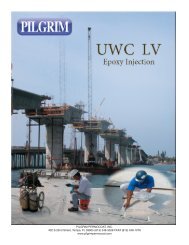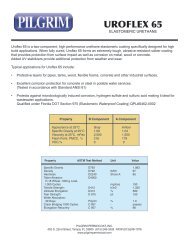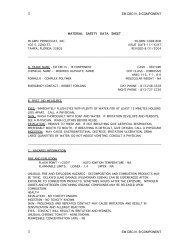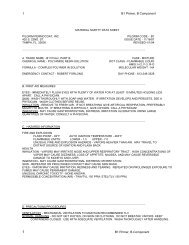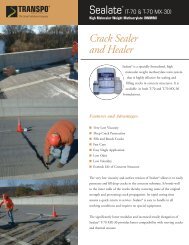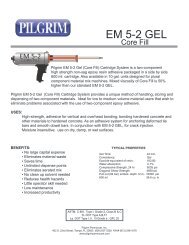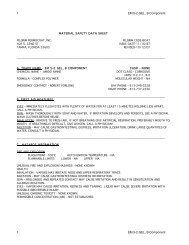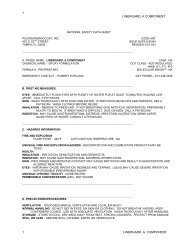CBC 6 Segmental Epoxy, Normal Set, A Component (70 ... - Pilgrim
CBC 6 Segmental Epoxy, Normal Set, A Component (70 ... - Pilgrim
CBC 6 Segmental Epoxy, Normal Set, A Component (70 ... - Pilgrim
- No tags were found...
Create successful ePaper yourself
Turn your PDF publications into a flip-book with our unique Google optimized e-Paper software.
<strong>CBC</strong> 6 <strong>Segmental</strong> <strong>Epoxy</strong>, <strong>Normal</strong> <strong>Set</strong>, A <strong>Component</strong> (<strong>70</strong>-115°)Material Safety Data SheetProduct Name: <strong>CBC</strong> 6 <strong>Segmental</strong> <strong>Epoxy</strong>, <strong>Normal</strong> <strong>Set</strong>, A <strong>Component</strong> (<strong>70</strong>°115°)Issue Date: 08/20/2007Print Date: 11 Dec 2010Page 1 of 10<strong>Pilgrim</strong> Permocoat, Inc. encourages and expects you to read and understand theentire (M)SDS, as there is important information throughout the document. Weexpect you to follow the precautions identified in this document unless your useconditions would necessitate other appropriate methods or actions.1. Product and Company IdentificationProduct Name<strong>CBC</strong> 6 <strong>Segmental</strong> <strong>Epoxy</strong>, <strong>Normal</strong> <strong>Set</strong>, A <strong>Component</strong> (<strong>70</strong>°115°)COMPANY IDENTIFICATION<strong>Pilgrim</strong> Permocoat, Inc.402 S. 22 nd StreetTampa, Florida 33605USACustomer Information Number: 800-637-33282. Hazards IdentificationEmergency OverviewColor: Off WhitePhysical State: GELOdor: MildHazards of product:WARNING! May cause allergic skin reaction. May cause eye irritation. Maycause skin irritation.OSHA Hazard Communication StandardThis product is a "Hazardous Chemical" as defined by the OSHA HazardCommunication Standard, 29CFR 1910.1200.Potential Health EffectsEye Contact: May cause eye irritation. Corneal injury is unlikely.Skin Contact: Prolonged contact may cause skin irritation with local redness.Repeated contact may cause skin irritation with local redness.Skin Absorption: Prolonged skin contact is unlikely to result in absorption ofharmful amounts.Skin Sensitization: Has caused allergic skin reactions in humans.Vapors are unlikely due to physical properties.<strong>CBC</strong> 6 <strong>Segmental</strong> <strong>Epoxy</strong>, <strong>Normal</strong> <strong>Set</strong>, A <strong>Component</strong> (<strong>70</strong>-115°) 1
<strong>CBC</strong> 6 <strong>Segmental</strong> <strong>Epoxy</strong>, <strong>Normal</strong> <strong>Set</strong>, A <strong>Component</strong> (<strong>70</strong>-115°)Ingestion: Very low toxicity if swallowed. Harmful effects not anticipated fromswallowing small amounts.Cancer Information: Many studies have been conducted to assess the potentialcarcinogenicity of diglycidyl ether of bisphenol A (DGEBPA). Indeed, the mostrecent review of the available data by the International Agency for Research onCancer (IARC) has concluded that DGEBPA is not classified as a carcinogen.Although some weak evidence of carcinogenicity has been reported in animals,when all of the data are considered, the weight of evidence does not show thatDGEBPA is carcinogenic.3.<strong>Component</strong><strong>Component</strong> CAS# AmountPropane, 2,2-bis[p-(2,3- 25085-99-8 >60%epoxypropoxy)phenyl]-,polymersSilica 14808-60-7
<strong>CBC</strong> 6 <strong>Segmental</strong> <strong>Epoxy</strong>, <strong>Normal</strong> <strong>Set</strong>, A <strong>Component</strong> (<strong>70</strong>-115°)Fire Fighting Procedures: Keep people away. Isolate fire and denyunnecessary entry. Use water spray to cool fire exposed containers and fireaffected zone until fire is out and danger of re-ignition has passed. Fight fire fromprotected location or safe distance. Consider the use of unmanned hose holdersor monitor nozzles. Immediately withdraw all personnel from the area in case ofrising soundfrom venting safety device or discoloration of the container. Do not use directwater stream. May spread fire. Move container from fire area if this is possiblewithout hazard. Burning liquids may be moved by flushing with water to protectpersonnel and minimize property damage. Water fog, applied gently may beused as a blanket for fire extinguishment. Contain fire water run-off if possible.Fire water run-off, if not contained, may cause environmental damage. Reviewthe "Accidental ReleaseMeasures" and the "Ecological Information" sections of this (M)SDS.Special Protective Equipment for Firefighters: Wear positive-pressure selfcontainedbreathing apparatus (SCBA) and protective fire fighting clothing(includes fire fighting helmet, coat, trousers, boots, and gloves). Avoid contactwith this material during fire fighting operations. If contact is likely, change to fullchemical resistant fire fighting clothing with self-contained breathing apparatus. Ifthis is not available, wear full chemical resistant clothing with self-containedbreathing apparatus and fight fire from a remote location. For protectiveequipment in post-fire or non-fire clean-up situations, refer to the relevantsections.Unusual Fire and Explosion Hazards: Container may rupture from gasgeneration in a fire situation.Violent steam generation or eruption may occur upon application of direct waterstream to hot liquids.Dense smoke is emitted when burned without sufficient oxygen.Hazardous Combustion Products: During a fire, smoke may contain theoriginal material in addition to combustion products of varying composition whichmay be toxic and/or irritating. Combustion products may include and are notlimited to: Phenolics. Carbon monoxide. Carbon dioxide.6. Accidental Release MeasuresSteps to be Taken if Material is Released or Spilled: Contain spilled material ifpossible. Absorb with materials such as: Sand. Polypropylene fiber products.Polyethylene fiber products. Remove residual with soap and hot water. Collect insuitable and properly labeled containers. Residual can be removed with solvent.Solvents are not recommended for clean-up unless the recommended exposureguidelines and safe handling practices for the specific solvent are followed.Consult appropriate solvent Safety Data Sheet for handling information andexposure guidelines. See Section 13, Disposal Considerations, for additionalinformation.<strong>CBC</strong> 6 <strong>Segmental</strong> <strong>Epoxy</strong>, <strong>Normal</strong> <strong>Set</strong>, A <strong>Component</strong> (<strong>70</strong>-115°) 3
<strong>CBC</strong> 6 <strong>Segmental</strong> <strong>Epoxy</strong>, <strong>Normal</strong> <strong>Set</strong>, A <strong>Component</strong> (<strong>70</strong>-115°)Personal Precautions: Isolate area. Keep unnecessary and unprotectedpersonnel from entering the area. Use appropriate safety equipment. Foradditional information, refer to Section 8, Exposure Controls and PersonalProtection. Refer to Section 7, Handling, for additional precautionary measures.Environmental Precautions: Prevent from entering into soil, ditches, sewers,waterways and/or groundwater. See Section 12, Ecological Information.7. Handling and StorageHandlingGeneral Handling: Avoid prolonged or repeated contact with skin. Avoid contactwith eyes. Avoid contact with skin and clothing. Wash thoroughly after handling.Avoid use of electric band heaters.Failures of electric band heaters have been reported to cause drums of liquidepoxy resin to explode and catch fire. Application of a direct flame to a containerof liquid epoxy resin can also cause explosion and/or fire.StorageKeep containers tightly closed. Keep out of reach of children.Shelf life: Use within Storage temperature:24 Months 2 - 43 °C8. Exposure Controls / Personal ProtectionExposure LimitsNone establishedPersonal ProtectionEye/Face Protection: Use safety glasses.Skin Protection: Use protective clothing chemically resistant to this material.Selection of specific items such as face shield, boots, apron, or full body suit willdepend on the task. Remove contaminated clothing immediately, wash skin areawith soap and water, and launder clothing before reuse or dispose of properly.Items which cannot be decontaminated, such as shoes, belts and watchbands,should be removed and disposed of properly.Hand protection: Use gloves chemically resistant to this material. Examples ofpreferred glove barrier materials include: Butyl rubber. Ethyl vinyl alcohollaminate ("EVAL"). Nitrile. Neoprene. Polyvinyl chloride ("PVC" or "vinyl").NOTICE: The selection of a specific glove for a particular application andduration of use in a workplace should also take into account all relevantworkplace factors such as, but not limited to: Other chemicals which may behandled, physical requirements (cut/puncture protection, dexterity, thermalprotection), potential body reactions to glove materials, as well as theinstructions/specifications provided by the glove supplier.<strong>CBC</strong> 6 <strong>Segmental</strong> <strong>Epoxy</strong>, <strong>Normal</strong> <strong>Set</strong>, A <strong>Component</strong> (<strong>70</strong>-115°) 4
<strong>CBC</strong> 6 <strong>Segmental</strong> <strong>Epoxy</strong>, <strong>Normal</strong> <strong>Set</strong>, A <strong>Component</strong> (<strong>70</strong>-115°)Respiratory Protection: No respiratory protection should be needed.Ingestion: Use good personal hygiene. Do not consume or store food in thework area. Wash hands before smoking or eating.Engineering ControlsVentilation: Good general ventilation should be sufficient for most conditions.9. Physical and Chemical PropertiesPhysical StateGelColorOff WhiteOdorMildFlash Point - Closed Cup252 °C (486 °F) PMCC, ASTM D93Flammable Limits In Air Lower: Not applicableUpper:Not applicableAutoignition TemperatureNot applicableVapor Pressure< 0.01 mmHg @ 25 °C LiteratureBoiling Point (760 mmHg) > 100 °C (> 212 °F) Literature .Vapor Density (air = 1)Not applicableSpecific Gravity (H2O = 1) 1.16 LiteratureFreezing PointNot determinedMelting PointNot determinedSolubility in Water (by weight) InsolublepHNot determinedDynamic Viscosity900-1200 mPa.s @ 25 °C ASTM D44510. Stability and ReactivityStability/InstabilityStable under recommended storage conditions. See Storage, Section 7.Conditions to Avoid: Avoid temperatures above 300°C (572°F) Potentiallyviolent decomposition can occur above 350°C (662°F) Generation of gas duringdecomposition can cause pressure in closed systems. Pressure build-up can berapid.Incompatible Materials: Avoid contact with oxidizing materials. Avoid contactwith: Acids. Bases.Avoid unintended contact with amines.Hazardous PolymerizationWill not occur by itself. Masses of more than one pound (0.5 kg) of product plusan aliphatic amine will cause irreversible polymerization with considerable heatbuild-up.<strong>CBC</strong> 6 <strong>Segmental</strong> <strong>Epoxy</strong>, <strong>Normal</strong> <strong>Set</strong>, A <strong>Component</strong> (<strong>70</strong>-115°) 5
<strong>CBC</strong> 6 <strong>Segmental</strong> <strong>Epoxy</strong>, <strong>Normal</strong> <strong>Set</strong>, A <strong>Component</strong> (<strong>70</strong>-115°)Thermal DecompositionDecomposition products depend upon temperature, air supply and the presenceof other materials.Gases are released during decomposition. Uncontrolled exothermic reaction ofepoxy resins release phenolics, carbon monoxide, and water.11. Toxicological InformationAcute ToxicityIngestionLD50, Rat > 5,000 mg/kgSkin AbsorptionLD50, Rabbit 20,000 mg/kgSensitizationSkinHas caused allergic skin reactions in humans. Did not cause allergic skinreactions when tested in mice.Repeated Dose ToxicityExcept for skin sensitization, repeated exposures to low molecular weight epoxyresins of this type are not anticipated to cause any significant adverse effects.Chronic Toxicity and CarcinogenicityMany studies have been conducted to assess the potential carcinogenicity ofdiglycidyl ether of bisphenol A (DGEBPA). Indeed, the most recent review of theavailable data by the InternationalAgency for Research on Cancer (IARC) has concluded that DGEBPA is notclassified as a carcinogen.Although some weak evidence of carcinogenicity has been reported in animals,when all of the data are considered, the weight of evidence does not show thatDGEBPA is carcinogenic.Developmental ToxicityResins based on the diglycidyl ether of bisphenol A (DGEBPA) did not causebirth defects or other adverse effects on the fetus when pregnant rabbits wereexposed by skin contact, the most likely route of exposure, or when pregnant ratsor rabbits were exposed orally.Reproductive ToxicityIn animal studies, did not interfere with reproduction.Genetic ToxicologyIn vitro genetic toxicity studies were negative in some cases and positive in othercases. Animal genetic toxicity studies were negative.12. Ecological InformationCHEMICAL FATEMovement & PartitioningBioconcentration potential is moderate (BCF between 100 and 3000 or Log Pow<strong>CBC</strong> 6 <strong>Segmental</strong> <strong>Epoxy</strong>, <strong>Normal</strong> <strong>Set</strong>, A <strong>Component</strong> (<strong>70</strong>-115°) 6
<strong>CBC</strong> 6 <strong>Segmental</strong> <strong>Epoxy</strong>, <strong>Normal</strong> <strong>Set</strong>, A <strong>Component</strong> (<strong>70</strong>-115°)between 3 and 5).Potential for mobility in soil is low (Koc between 500 and 2000).Henry's Law Constant (H): < 6.94E-09 atm*m3/mole; 25 °C EstimatedPartition coefficient, soil organic carbon/water (Koc): 1,800 - 4,400Estimated1,800 - 4,400EstimatedPersistence and DegradabilityBiodegradation under aerobic laboratory conditions is below detectable limits(BOD20 orBOD28/ThOD < 2.5%).Indirect Photodegradation with OH RadicalsRate Constant Atmospheric Half-life Method6.69E-11 cm3/s 1.92 h EstimatedOECD Biodegradation Tests:Biodegradation Exposure Time Method12 % 28 d OECD 302B TestBiological oxygen demand (BOD):BOD 5 BOD 10 BOD 20 BOD 28< 2.5 %Theoretical Oxygen Demand: 2.35 mg/mgECOTOXICITYMaterial is moderately toxic to aquatic organisms on an acute basis (LC50/EC50between 1 and 10 mg/L in most sensitive species tested). Toxicity to aquaticspecies occurs at concentrations above material's water solubility.Fish Acute & Prolonged ToxicityLC50, fathead minnow (Pimephales promelas), 96 h: 3.1 mg/lAquatic Invertebrate Acute ToxicityEC50, water flea Daphnia magna, 48 h, immobilization: 1.4 - 1.7 mg/lToxicity to Micro-organismsIC50; bacteria, Growth inhibition, 18 h: > 42.6 mg/l13. Disposal ConsiderationsDO NOT DUMP INTO ANY SEWERS, ON THE GROUND, OR INTO ANY BODYOF WATER. All disposal practices must be in compliance with all Federal,State/Provincial and local laws and regulations. Regulations may vary in differentlocations. Waste characterizations and compliance with applicable laws are theresponsibility solely of the waste generator. PILGRIM HAS NO CONTROL OVERTHE MANAGEMENT PRACTICES OR MANUFACTURING PROCESSES OFPARTIES HANDLING OR USING THIS MATERIAL. THE INFORMATION<strong>CBC</strong> 6 <strong>Segmental</strong> <strong>Epoxy</strong>, <strong>Normal</strong> <strong>Set</strong>, A <strong>Component</strong> (<strong>70</strong>-115°) 7
<strong>CBC</strong> 6 <strong>Segmental</strong> <strong>Epoxy</strong>, <strong>Normal</strong> <strong>Set</strong>, A <strong>Component</strong> (<strong>70</strong>-115°)PRESENTED HERE PERTAINS ONLY TO THE PRODUCT AS SHIPPED INITS INTENDED CONDITION AS DESCRIBED IN MSDS SECTION:Composition Information. FOR UNUSED & UNCONTAMINATED PRODUCT, thepreferred options include sending to a licensed, permitted: Incinerator or otherthermal destruction device.14. Transport InformationDOT Non-BulkNOT REGULATEDDOT BulkNOT REGULATEDIMDGNOT REGULATEDICAO/IATANOT REGULATEDThis information is not intended to convey all specific regulatory or operationalrequirements/information relating to this product. Additional transportation systeminformation can be obtained through an authorized sales or customer servicerepresentative. It is the responsibility of the transporting organization to follow allapplicable laws, regulations and rules relating to the transportation of thematerial.15. Regulatory InformationOSHA Hazard Communication StandardThis product is a "Hazardous Chemical" as defined by the OSHA HazardCommunication Standard, 29CFR 1910.1200.Superfund Amendments and Reauthorization Act of 1986 Title III(Emergency Planning and Community Right-to-Know Act of 1986) Sections311 and 312Immediate (Acute) Health HazardYesDelayed (Chronic) Health HazardNoFire HazardNoReactive HazardNoSudden Release of Pressure Hazard NoSuperfund Amendments and Reauthorization Act of 1986 Title III(Emergency Planning andCommunity Right-to-Know Act of 1986) Section 313<strong>CBC</strong> 6 <strong>Segmental</strong> <strong>Epoxy</strong>, <strong>Normal</strong> <strong>Set</strong>, A <strong>Component</strong> (<strong>70</strong>-115°) 8
<strong>CBC</strong> 6 <strong>Segmental</strong> <strong>Epoxy</strong>, <strong>Normal</strong> <strong>Set</strong>, A <strong>Component</strong> (<strong>70</strong>-115°)To the best of our knowledge, this product does not contain chemicals at levelswhich require reporting under this statute.Pennsylvania (Worker and Community Right-To-Know Act): PennsylvaniaHazardousSubstances List and/or Pennsylvania Environmental Hazardous SubstanceList:To the best of our knowledge, this product does not contain chemicals at levelswhich require reporting under this statute.Pennsylvania (Worker and Community Right-To-Know Act): PennsylvaniaSpecial HazardousSubstances List:To the best of our knowledge, this product does not contain chemicals at levelswhich require reporting under this statute.California Proposition 65 (Safe Drinking Water and Toxic Enforcement Actof 1986)This product contains no listed substances known to the State of California tocause cancer, birth defects or other reproductive harm, at levels which wouldrequire a warning under the statute.European Inventory of Existing Commercial Chemical Substances(EINECS)<strong>Component</strong>s of this product are not listed on EINECS because they are polymersor "no-longer polymers" marketed before the enforcement of the 7th Amendmentto Directive 67/548/EEC.US. Toxic Substances Control ActAll components of this product are on the TSCA Inventory or are exempt fromTSCA Inventory requirements under 40 CFR 720.30CEPA - Domestic Substances List (DSL)All substances contained in this product are listed on the Canadian DomesticSubstances List (DSL) or are not required to be listed.16. Other InformationProduct LiteratureAdditional information on this product may be obtained by calling your <strong>Pilgrim</strong>sales or customer service contact. Ask for a product brochure.Hazard Rating SystemNFPA Health Fire Reactivity1 1 2Recommended Uses and RestrictionsUsed in applications such as: Adhesive. Casting. Tooling. Civil engineering.<strong>CBC</strong> 6 <strong>Segmental</strong> <strong>Epoxy</strong>, <strong>Normal</strong> <strong>Set</strong>, A <strong>Component</strong> (<strong>70</strong>-115°) 9
<strong>CBC</strong> 6 <strong>Segmental</strong> <strong>Epoxy</strong>, <strong>Normal</strong> <strong>Set</strong>, A <strong>Component</strong> (<strong>70</strong>-115°)LegendN/ANot availableW/WWeight/WeightOELOccupational Exposure LimitSTELShort Term Exposure LimitTWATime Weighted AverageACGIHAmerican Conference of Governmental Industrial HygienistsWEELWorkplace Environmental Exposure LevelHAZ_DES Hazard DesignationAction Level A value set by OSHA that is lower than the PEL which willtrigger the need for activities such as exposure monitoring and medicalsurveillance if exceeded.<strong>Pilgrim</strong> Permocoat, Inc. urges each customer or recipient of this (M)SDS to studyit carefully and consult appropriate expertise, as necessary or appropriate, tobecome aware of and understand the data contained in this (M)SDS and anyhazards associated with the product. The information herein is provided in goodfaith and believed to be accurate as of the effective date shown above. However,no warranty, express or implied, is given. Regulatory requirements are subject tochange and may differ between various locations. It is the buyer's/user'sresponsibility to ensure that his activities comply with all federal, state, provincialor local laws. The information presented here pertains only to the productas shipped. Since conditions for use of the product are not under the control ofthe manufacturer, it is the buyer's/user's duty to determine the conditionsnecessary for the safe use of this product. Due to the proliferation of sources forinformation such as manufacturer-specific (M)SDSs, we are not and cannot beresponsible for (M)SDSs obtained from any source other than ourselves. If youhave obtained an (M)SDS from another source or if you are not sure that the(M)SDS you have is current, please contact us for the most current version.<strong>CBC</strong> 6 <strong>Segmental</strong> <strong>Epoxy</strong>, <strong>Normal</strong> <strong>Set</strong>, A <strong>Component</strong> (<strong>70</strong>-115°) 10



